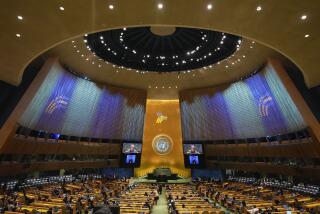Verification--With Strategic Arms, Job Gets Tougher
- Share via
WASHINGTON — When the United States and the Soviet Union negotiated the first arms control agreements of the nuclear age in 1972, they covered missile defense systems in six typewritten pages and kissed off offensive weaponry in 1 1/2 pages. By contrast, the intermediate nuclear forces treaty that President Reagan and Soviet leader Mikhail S. Gorbachev expect to sign next month will run about 200 pages.
The growing complexity reflects a new effort by both nations to avoid the ambiguities and loopholes that marked the 1972 pacts. But if the negotiators continue to try to dot every “i” and cross every “t” in drafting an inherently far more complicated treaty to slash superpower arsenals of long-range strategic weapons, the crucial next stage of arms control talks may be swamped in a sea of paper.
Still Arguing Some Points
Although the two sides are still arguing about some of the more arcane aspects of the proposed treaty to ban nuclear missiles with maximum ranges between 300 and 3,000 miles, U.S. and Soviet officials both are predicting that the work will be completed in time for Reagan and Gorbachev to sign the pact during the summit meeting scheduled to begin Dec. 7.
Reagan likes to refer to the emerging treaty as history’s first agreement to scrap an entire class of nuclear weapons. But, from a military standpoint, its effect is limited, because strategic weapons, which can be fired at less than their maximum ranges, can destroy intermediate-range targets although the reverse is not true.
Unless the United States and the Soviet Union take the next step of drafting a strategic arms reduction treaty (START), the intermediate nuclear forces (INF) pact would be “a largely political agreement, the meaning of which depends on how governments and publics read it in the future,” said Stephen R. Sestanovich, a former Administration expert on the Soviet Union.
Sestanovich, now director of Soviet studies at the Center for Strategic and International Studies in Washington, said the INF pact “reflects a series of rather important concessions by the Soviets, but the Soviets can hit every target with other systems that they could have hit with the SS-20,” the most dangerous Soviet weapon to be destroyed under the treaty.
“Of course, you can target an ICBM (intercontinental ballistic missile) at Europe,” said Ralph Earle II, the chief arms control negotiator during the Jimmy Carter Administration. “I’ve always said that an INF agreement doesn’t mean anything without a START agreement.”
Importance Acknowledged
Earle said that before the Soviet deployment of the SS-20, Moscow targeted some of its SS-11 ICBMs on Europe. When the SS-20s are removed, it could do so again.
In a joint statement issued Oct. 30, the United States and the Soviet Union acknowledged the importance of following up the INF agreement with a strategic arms pact. The statement said the negotiators would make every effort to reach a strategic arms agreement in the first half of 1988, which could be signed during a Reagan visit to Moscow before next June 30.
But progress toward a strategic arms agreement has been slowed by two separate problems. First, the Soviet Union has said it will conclude a strategic arms treaty only if the United States agrees to curtail its Strategic Defense Initiative, the anti-missile program often called “Star Wars.” Second, U.S. officials have said that strategic arms provisions, especially verification procedures, are far more complex than intermediate missile provisions.
Chances ‘About 50-50’
There have been some hints that Moscow may be ready to bend on its attempt to link strategic arms reductions to “Star Wars” curbs.
John B. Rhinelander, legal adviser to the U.S. delegation that negotiated the original Anti-Ballistic Missile Treaty in 1972, said it appears likely that the Soviets will accept, for the time being at least, the restrictions on the Strategic Defense Initiative, which Congress is expected to impose on the White House in any case. If that happens, he said, the chances of a strategic arms reduction agreement before Reagan leaves office are “about 50-50.”
But even if Moscow yields on the “Star Wars” linkage, the strategic arms talks could reach a stalemate because of the sheer complexity of the subject.
Secretary of State George P. Shultz has said that verification of the INF, or intermediate-range missile, treaty is simple in comparison to strategic missiles. Under the INF pact, manufacture, deployment and storage of missiles with 300- to 3,000-mile ranges would be outlawed. Shultz reasoned that it is easier to police a total ban than it would be to make sure that the count of weapons does not exceed some agreed number.
Reagan and Gorbachev have already agreed that the objective of the START negotiations is to reduce strategic weapons arsenals by half, to about 6,000 warheads on each side.
Rhinelander said that if the negotiators try to find ways to make sure that neither side has 6,001 warheads, the verification procedures will become almost impossibly cumbersome. He said that problem could be solved, as it was in earlier arms control treaties, by a tacit agreement that gross violations could be detected and small ones have no military significance.
But such a verification agreement may be politically impossible. Already, every Republican presidential candidate except Vice President George Bush has said the INF treaty may not be verifiable. U.S. officials said the effort to achieve total reliability is the main reason the text of the treaty ballooned to 200 pages.
More to Read
Sign up for Essential California
The most important California stories and recommendations in your inbox every morning.
You may occasionally receive promotional content from the Los Angeles Times.













